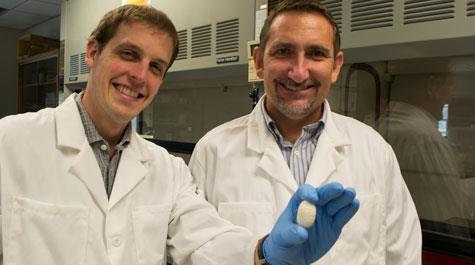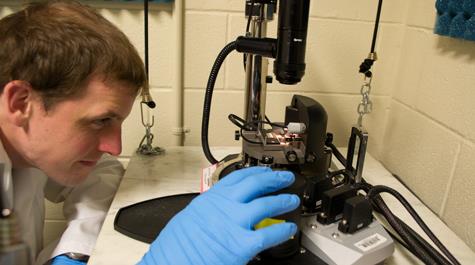Unraveling the secret of silk that's more alive than dead
Hannes Schniepp and Sean Koebley talk about silk as being either alive or dead.
They aren’t talking about the silk of scarves and dresses. The finest garment-quality silks are made gently, by boiling silkworm cocoons just enough to dissolve a rubbery coating before spinning the fibers into thread. But Schniepp explained that silk has had a long history as a utilitarian fabric, as well.
Today, silk is being examined for a wide range of medical uses, ranging from membranes to scaffolding to foster the healing of wounds. Silks used in research and medical settings undergo much harsher processing, a chemical ordeal that effectively “kill” the silk and removes many of the qualities that make it such a wonderful substance in the first place.
Schniepp maintains that the finest, smoothest, strongest of these synthetic silks are still dead, and therefore a poor substitute for silk that is alive, the unprocessed, straight-from-the-silkworm’s-mouth fiber. Schniepp and Koebley are part of a collaboration that has begun to unravel the secret of the silkworm, an important first step in learning how to produce silks that are more alive than dead.
Schniepp is an associate professor in William & Mary’s Department of Applied Science. Koebley, a 2008 W&M graduate, is a Ph.D. student. They are authors on a paper that also includes Fritz Vollrath from the Oxford Silk Group at Oxford University in the UK. Other William & Mary authors are Schniepp’s former research undergraduate students Daniel Thorpe, Pei Pang and Panos Chrisochoides. Their paper, “Silk Reconstitution Disrupts Fibroin Self-Assembly,” was featured in the American Chemical Society journal Biomacromolecules.
Fibroin is a biomolecule, a protein component in the semi-liquid “dope” produced by silkworms and spun into cocoons. Like other biomolecules, fibroin proteins have attributes that cause scientists to talk about them as if they were alive. Under the right conditions, the fibroin molecules fold, extend and assemble into structures, creating from aqueous dope a strong, complex water-resistant fiber.
The silk processing technique used by many labs to create synthetic silk dope, known as reconstitution, “kills” the fibroin, destroying its molecular ability to self-assemble, leaving you with random, unorganized fibers: dead silk. Schniepp pointed out that fibroin and other natural polymers are much larger and more complex than the molecules that make up silk substitutes such as nylon.
“Even with all the tools that we have today, it’s a challenge trying to figure out which molecule is sitting where in the fiber and how it is interacting with the other molecules,” Schniepp said. “There are so many things we don’t know and do not understand.”
As complex as the product of silkworms may appear at the molecular level, it’s pretty basic stuff compared to the material used in spider webs. Schniepp also studies spider silk, a material that, molecularly speaking, is much more highly advanced.
“If you look at all of the animals out there that produce silk, you find that worm silk, which is the only kind we can produce in large quantities — it’s really pretty boring,” he said.
The research outlined in the Biomacromolecules paper represents a good first step toward understanding the mechanisms of silk on the molecular level. Schniepp’s lab worked with a couple of dozen silkworms and their cocoons, using atomic force microscopy to compare processed “dead” silk with the fresh, worm-spun, “alive” material.
The first step was to understand what a silkworm actually does when it spins its dope into cocoon, and then figure out a way to replicate the action in the lab.
“What happens is the worms pass the dope through their mouth,” Koebley explained. “It goes through a spinning duct and it experiences a shear force at the edge of the duct. That shear force is extremely important in aligning the proteins in the right way.”
The lab was able to re-create the shear force of the silkworm’s spinning nozzle by using a technique known as spin coating. They dissected live silkworms and extract the dope: “It’s as natural as you can get,” Koebley said. The researchers place a dollop of the dope on a flat surface and turn on the spin coater.
“We are looking for that radial shear force to spread out that droplet,” he said. “The water in the droplet completely evaporates and that shear force causes that protein to assemble into long fibrils — which is exactly what we find on the surface of natively spun spider and silkworm silk.”
For comparison purposes, they replicated the processing of silk, dissolving cocoons in a harsh lithium bromide salt to form synthetic silk dope..
The researchers examined both versions of silk using atomic force microscopy. Schniepp’s lab specializes in the use of this imaging technique, which gives the researchers the capability of observing a specimen just a few nanometers wide. Schniepp explained that many of today’s most powerful tools available to scientists aren’t much use for inspection of biomolecules because they tend to alter or even destroy the sample. Electron microscopes, for instance, are powerful enough, but require the sample to be placed in a vacuum — an unnatural state.
“The microscopy is very important,” Schniepp said. “Because when we’re talking about biological materials, they just behave different than other ways. That’s the reason why we don’t know a lot about silk. It’s so difficult to study.”
The goal to understanding the molecular mechanism of silk is not to just make a better kimono. Schniepp points out that silk has been a high-tech material for thousands of years, used for airplane skin, parachutes, reinforcing tires and a wide range of uses beyond clothing.
The product of silkworm and spiders has potential for a whole new set of applications. Schniepp said that as silk is a natural material, it’s also bio-friendly, making it a natural choice for a material to line medical implants, for instance. The “dead” silks of the past aren’t up to the requirements of the future, though.
“If you start with that cocoon, and you want to process it into something that’s not a fiber, you need to learn more about it,” Schniepp said. Skip to main content
Skip to main content


